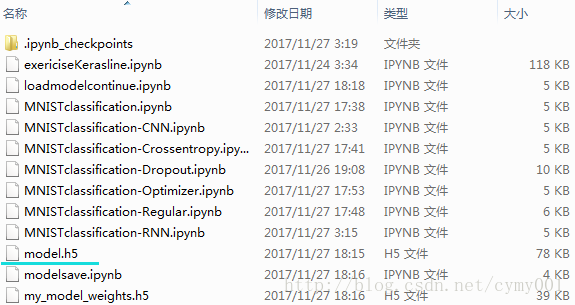我们以MNIST手写数字识别为例
import numpy as np from keras.datasets import mnist from keras.utils import np_utils from keras.models import Sequential from keras.layers import Dense from keras.optimizers import SGD # 载入数据 (x_train,y_train),(x_test,y_test) = mnist.load_data() # (60000,28,28) print('x_shape:',x_train.shape) # (60000) print('y_shape:',y_train.shape) # (60000,28,28)->(60000,784) x_train = x_train.reshape(x_train.shape[0],-1)/255.0 x_test = x_test.reshape(x_test.shape[0],-1)/255.0 # 换one hot格式 y_train = np_utils.to_categorical(y_train,num_classes=10) y_test = np_utils.to_categorical(y_test,num_classes=10) # 创建模型,输入784个神经元,输出10个神经元 model = Sequential([ Dense(units=10,input_dim=784,bias_initializer='one',activation='softmax') ]) # 定义优化器 sgd = SGD(lr=0.2) # 定义优化器,loss function,训练过程中计算准确率 model.compile( optimizer = sgd, loss = 'mse', metrics=['accuracy'], ) # 训练模型 model.fit(x_train,y_train,batch_size=64,epochs=5) # 评估模型 loss,accuracy = model.evaluate(x_test,y_test) print(' test loss',loss) print('accuracy',accuracy) # 保存模型 model.save('model.h5') # HDF5文件,pip install h5py


载入初次训练的模型,再训练
import numpy as np from keras.datasets import mnist from keras.utils import np_utils from keras.models import Sequential from keras.layers import Dense from keras.optimizers import SGD from keras.models import load_model # 载入数据 (x_train,y_train),(x_test,y_test) = mnist.load_data() # (60000,28,28) print('x_shape:',x_train.shape) # (60000) print('y_shape:',y_train.shape) # (60000,28,28)->(60000,784) x_train = x_train.reshape(x_train.shape[0],-1)/255.0 x_test = x_test.reshape(x_test.shape[0],-1)/255.0 # 换one hot格式 y_train = np_utils.to_categorical(y_train,num_classes=10) y_test = np_utils.to_categorical(y_test,num_classes=10) # 载入模型 model = load_model('model.h5') # 评估模型 loss,accuracy = model.evaluate(x_test,y_test) print(' test loss',loss) print('accuracy',accuracy) # 训练模型 model.fit(x_train,y_train,batch_size=64,epochs=2) # 评估模型 loss,accuracy = model.evaluate(x_test,y_test) print(' test loss',loss) print('accuracy',accuracy) # 保存参数,载入参数 model.save_weights('my_model_weights.h5') model.load_weights('my_model_weights.h5') # 保存网络结构,载入网络结构 from keras.models import model_from_json json_string = model.to_json() model = model_from_json(json_string) print(json_string)
关于compile和load_model()的使用顺序
这一段落主要是为了解决我们fit、evaluate、predict之前还是之后使用compile。想要弄明白,首先我们要清楚compile在程序中是做什么的?都做了什么?
compile做什么?
compile定义了loss function损失函数、optimizer优化器和metrics度量。它与权重无关,也就是说compile并不会影响权重,不会影响之前训练的问题。
如果我们要训练模型或者评估模型evaluate,则需要compile,因为训练要使用损失函数和优化器,评估要使用度量方法;如果我们要预测,则没有必要compile模型。
是否需要多次编译?
除非我们要更改其中之一:损失函数、优化器 / 学习率、度量
又或者我们加载了尚未编译的模型。或者您的加载/保存方法没有考虑以前的编译。
再次compile的后果?
如果再次编译模型,将会丢失优化器状态.
这意味着您的训练在开始时会受到一点影响,直到调整学习率,动量等为止。但是绝对不会对重量造成损害(除非您的初始学习率如此之大,以至于第一次训练步骤疯狂地更改微调的权重)。